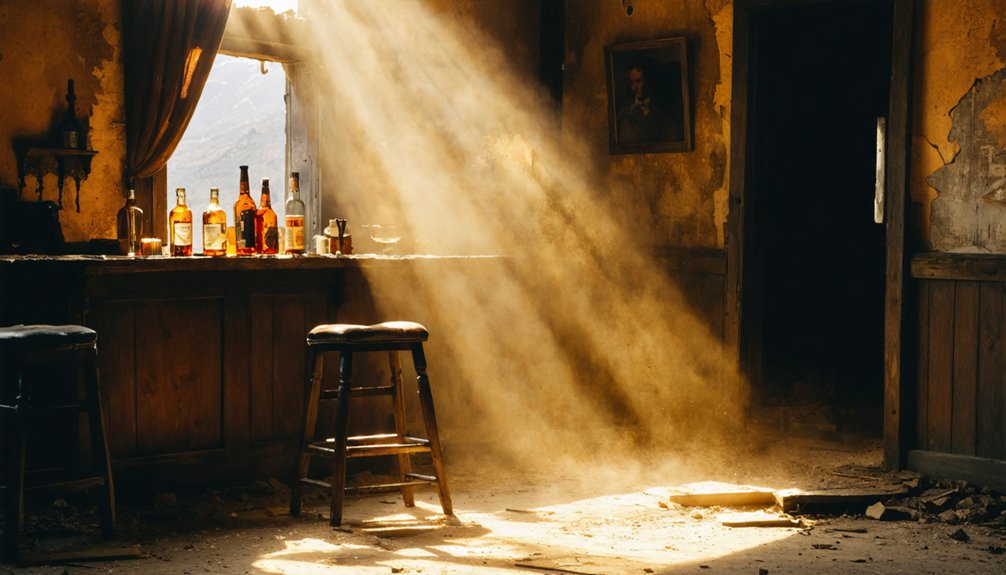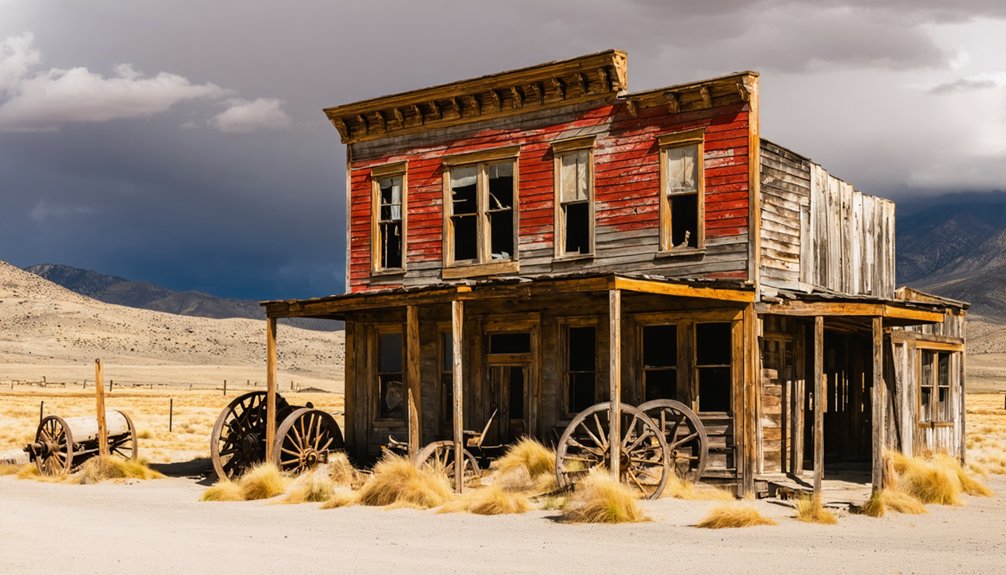You’ll find fascinating history frozen in time across America’s eeriest ghost towns. Explore Bodie’s lawless saloons, walk Bannack’s streets where vigilantes once ruled, or witness Centralia’s apocalyptic smoking landscape. Don’t miss St. Elmo’s preserved mining structures, Terlingua’s mercury-mining past, or Rhyolite’s rapid rise and fall. Each abandoned settlement tells a unique story of boom and bust that will transport you to another era.
Key Takeaways
- Bodie, California features 100+ buildings in “arrested decay” and preserves authentic Wild West history with its violent past.
- Bannack, Montana offers 60 preserved buildings and infamous history of vigilante justice against Sheriff Plummer’s gang.
- Pripyat, Ukraine stands as a haunting monument to the Chernobyl nuclear disaster with regulated tourism experiences available.
- Centralia, Pennsylvania features an eerie landscape with smoke rising from pavement due to an underground coal fire burning since 1962.
- Terlingua, Texas combines mining history with breathtaking night skies and a historic cemetery with graves dating to 1902.
Bodie, California: The Perfectly Preserved Mining Town
While gold was discovered in the Sierra Nevada foothills in 1859, Bodie’s story begins with a touch of irony. W.S. Bodey, the prospector who found gold, perished in a blizzard before witnessing the town’s spectacular rise—and his name was misspelled as “Bodie” on official documents.
You’ll be walking through authentic Bodie history when you visit this perfectly preserved slice of America’s mining legacy. After a rich gold vein was exposed in 1876, the population exploded to nearly 10,000 by 1880. The town earned a reputation for daily violence and lawlessness, with approximately 65 saloons, brothels, and gambling halls catering to miners and drifters. The town’s vibrant China Town district contributed significantly to Bodie’s economy through laundry services and logging operations. The town produced an astonishing $38 million in precious metals before declining after 1913.
Today, Bodie stands in “arrested decay”—over 100 buildings remain exactly as residents left them. As California’s official gold rush ghost town, it offers you freedom to explore genuine remnants of the Wild West.
Bannack, Montana: A Lawless Gold Rush Settlement
When you visit Bannack, you’ll walk the same streets where the infamous Sheriff Henry Plummer led his ruthless “Innocents” gang before meeting justice at the end of a vigilante rope.
The town’s violent past comes alive during the annual Ghost Walks, when actors reenact the settlement’s most notorious events by lantern light.
You can almost hear the echoes of frontier justice as you stand beneath the gallows where outlaws met their fate. In its heyday, the gold rush town exploded to over 10,000 residents by late 1864, before ultimately declining as the precious metal deposits were depleted.
Today, visitors can explore 60 preserved buildings that offer an authentic glimpse into Montana’s gold rush era.
Sheriff Plummer’s Violent Gang
As gold fever swept across Montana Territory in 1862, it birthed one of the West’s most infamous criminal enterprises in Bannack, where Sheriff Henry Plummer orchestrated a reign of terror unmatched in frontier history.
When you visit this preserved ghost town, you’re walking the same streets where Plummer’s gang, known as “The Innocents,” once controlled every aspect of frontier life.
Despite being elected to protect citizens, Plummer and his deputies—secretly members of his 100-strong criminal organization—robbed gold shipments and murdered over 100 people.
Their criminal operations were centered at Rattlesnake Ranch, located twelve miles from Virginia City, which served as their headquarters for planning robberies and coordinating activities.
During Bannack’s peak in spring 1863, the town swelled to over five thousand residents, many unaware of the criminal element operating among them.
Their reign ended dramatically when local citizens formed a vigilante committee, hanging Plummer and at least 20 gang members without trial in early 1864.
This brutal vigilante justice remains controversial today, with Plummer’s guilt still debated in Montana’s historical circles.
Annual Ghost Walks
Once the sun sets over Bannack’s weathered buildings, the ghosts of Montana’s most notorious gold rush town seemingly come alive during the annual Ghost Walks hosted by Bannack State Park.
You’ll experience the haunted tours firsthand as guides lead you through legendary locations like Hotel Meade, where Dorothy Dunn’s spirit reportedly lingers, and the old jail where vigilante hangings took place.
The schoolhouse and residential cabins echo with voices from the past as you navigate through specially lit pathways enhanced with eerie sound effects.
These family-friendly yet spine-tingling events typically run during fall, featuring historical reenactments and storytelling sessions that bring ghostly legends to life.
Your participation helps fund preservation efforts while offering chances to capture unexplained phenomena in your photos.
For freedom-seeking adventurers and history buffs alike, these immersive nocturnal experiences provide the perfect blend of education and supernatural thrills.
Founded after a major gold deposit was struck in 1862, Bannack quickly grew to a booming population of several thousand before eventually becoming a ghost town.
The town became notorious for its lawlessness, with even Sheriff Henry Plummer leading a gang of road agents who terrorized travelers and miners.
Terlingua, Texas: From Mercury Mining to Tourist Haven
You’ll step back in time as you explore Terlingua’s corrugated steel and adobe structures, remnants of a once-thriving mercury mining operation that flourished until 1945.
What began as a Mexican village transformed dramatically when cinnabar was discovered, creating a boom town that later collapsed into near abandonment after the mines closed.
The ghost town has unexpectedly risen from the desert dust with its famous Chili Cookoff drawing thousands of visitors annually, breathing new life into this hauntingly beautiful relic of American mining history. The town was officially named the Chili Capital of America in 1967, cementing its new identity as a cultural destination. Visitors can experience breathtaking views of the night sky as Terlingua sits within the International Dark Sky Park, making it a premier destination for stargazers.
The Mercury Mining Era
Beneath the rugged terrain of West Texas lies the fascinating history of Terlingua, where the discovery of cinnabar ore in the mid-1880s transformed this remote desert outpost into a thriving mercury mining hub.
When you visit, you’re walking on ground once controlled by the Chisos Mining Company, which became America’s largest mercury producer during World War I. The operation boomed as mercury became essential for manufacturing explosives, with daily profits reaching $2,000.
Howard Perry’s enterprise built an entire community here, with nearly 2,000 residents at its peak. The mining legacy remains visible today, though be cautious—unmarked shafts pose safety risks, and mercury hazards still linger in processing areas.
Unexpected Desert Revival
While the mercury mining days faded into history by the 1940s, Terlingua has risen from the desert dust in remarkable fashion, transforming from an abandoned industrial site into a quirky tourist destination that attracts adventurers, artists, and history buffs alike.
You’ll find the town’s revival evident in restored buildings housing art galleries, unique lodging options, and the historic Starlight Theatre, now serving meals where silent films once played.
Despite modernization, cultural preservation remains central—the Terlingua Cemetery continues as an active site where visitors leave offerings at graves dating to 1902.
As you explore, you’ll notice how new businesses respect the fragile desert ecology surrounding the settlement.
Panoramic views of distant Mexican mountains and the Chisos range create the perfect backdrop for this unexpected renaissance in Texas’s remote borderlands.
Centralia, Pennsylvania: The Town That Burns Below
As you approach Centralia, Pennsylvania, you’ll notice an eerie landscape where wisps of smoke rise from cracked pavement and barren ground, signaling the inferno that’s been raging below since 1962.
What began as a simple trash fire ignited an underground coal seam that continues burning today.
The ghostly whispers of this town’s past echo through nearly-empty streets where 1,300 residents once lived.
Time has abandoned these streets, leaving memories to drift like smoke through the void where community once thrived.
Now, just five stubborn souls remain despite the dangers. The underground inferno reaches temperatures exceeding 900 degrees, venting toxic gases through fissures in the earth.
Though officials discourage visitors due to sinkholes and poisonous emissions, Centralia’s apocalyptic scenery inspired the horror franchise Silent Hill.
If you venture here, tread carefully—beneath your feet lies a 63-year-old fire that refuses to die.
St. Elmo, Colorado: Mountain Mining Glory Days Frozen in Time

Nestled high in the Collegiate Peaks of Colorado at nearly 10,000 feet elevation, St. Elmo stands as one of America’s best-preserved ghost towns.
Once a booming mining hub with 2,000 residents in the 1890s, you’ll find its glory days frozen in time.
The town’s mining legacy began with the Mary Murphy Mine in 1873, transforming from Forest City to St. Elmo in 1880.
At its peak, the district boasted over 150 mine claims, five hotels, and numerous businesses before fire and resource depletion triggered its abandonment by the early 1920s.
Unlike many ghost towns, you can drive directly into St. Elmo year-round.
Explore well-preserved historic buildings, hike nearby trails, or imagine the raucous Saturday nights when Alpine Tunnel construction workers descended on the town.
Animas Forks, Colorado: Abandoned After the Great Winter Blizzard
Perched at a breathtaking 11,200 feet elevation in the San Juan Mountains, Animas Forks stands as one of America’s highest ghost towns with a dramatic history of boom and abandonment.
Founded in 1873 as a mining settlement, this once-thriving community boasted 400 summer residents at its peak in 1883. Its mining heritage lives on through preserved structures where ghostly legends whisper of those who endured brutal 25-foot snowfalls before abandoning their dreams after the 1893 silver crash.
The whispers of forgotten dreams echo among weathered timbers—silver fortunes turned to dust beneath Colorado’s unforgiving mountain sky.
- Explore the dozen remaining buildings that once housed saloons, stores, and a two-cell jail
- Wander through a town that once had electricity and telegraph—remarkable luxuries at this remote elevation
- Follow the paths where residents once dug snow tunnels between buildings during harsh winters
- Experience the eerie silence that replaced the bustle of stagecoaches and mining operations
- Discover why the Bureau of Land Management now protects this slice of American frontier spirit
Rhyolite, Nevada: From Boom to Bust in Just Six Years

While Animas Forks illustrates the harsh realities of mountain mining life, Rhyolite stands as perhaps the most dramatic tale of overnight fortune and abandonment in American mining history. Founded in 1904 after a gold discovery, this Nevada boomtown exploded to 5,000 residents by 1907, only to be virtually deserted by 1920.
You’ll be amazed by the remaining ghost town architecture – the partially intact three-story bank building, train depot, and the unique Bottle House constructed of thousands of bottles embedded in concrete.
The town’s meteoric six-year rise and fall exemplifies the fragile nature of mining town legacy in the American West.
Now managed by the Bureau of Land Management, Rhyolite’s haunting ruins against the desert landscape make it one of the most photographed ghost towns you can explore.
Pripyat, Ukraine: The Chernobyl Disaster’s Frozen Moment
Unlike any ghost town on Earth, Pripyat stands as humanity’s most profound monument to nuclear disaster.
This Soviet city, once home to 49,000 residents, was evacuated 36 hours after the 1986 Chernobyl reactor explosion.
Today, you can join regulated Chernobyl tourism experiences to witness time frozen in radioactive amber—Soviet-era apartments, an abandoned amusement park, and decaying cultural centers.
- Explore the iconic Ferris wheel that never officially opened
- Witness nature’s reclamation as radioactive wildlife flourishes in humanity’s absence
- Walk through schools with books still open on desks from April 1986
- Photograph the eerie decay of a once-thriving Soviet city
- Experience firsthand the sobering reality of nuclear catastrophe while maintaining safe radiation exposure levels
Frequently Asked Questions
Are Any Ghost Towns Inhabited by Caretakers Year-Round?
Yes, while most ghost towns stand abandoned, you’ll discover fascinating caretaker stories in places like Cerro Gordo, California, where year-round residents preserve ghost town history while braving isolation and harsh conditions.
What Safety Precautions Should Visitors Take When Exploring Ghost Towns?
Bring essential safety gear including sturdy boots, flashlights, and first aid kits. Maintain wildlife awareness by scanning surroundings. Watch for structural hazards, respect property boundaries, and always explore with companions during daylight hours.
Can Visitors Legally Collect Artifacts or Souvenirs From Ghost Towns?
Thinking of taking a souvenir home? You generally can’t legally collect artifacts from ghost towns. Legal regulations protect these treasures through artifact preservation laws on public lands and require landowner permission on private property.
Which Ghost Towns Are Most Accessible for Visitors With Disabilities?
You’ll find the most accessible attractions at Bodie with terrain wheelchairs, Garnet’s main street buildings, and BLM sites like Fairbank and Empire Ranch that feature wheelchair ramps and adapted pathways.
Do Any Ghost Towns Offer Overnight Accommodation Options?
Four out of five ghost towns offer overnight accommodations! You’ll find options from St. Elmo’s intimate B&B to Dunton’s luxury resort. Experience overnight ghosting in historic buildings with modern comforts.
References
- https://www.christywanders.com/2024/08/top-ghost-towns-for-history-buffs.html
- https://en.wikipedia.org/wiki/Wikipedia:WikiProject_Ghost_towns
- https://whakestudios.com/us-ghost-towns/
- https://www.businessinsider.com/eeriest-things-seen-while-exploring-abandoned-ghost-towns-2022-10
- https://www.visittheusa.com/experience/5-us-ghost-towns-you-must-see
- https://www.countryliving.com/life/travel/g2665/spookiest-ghost-towns-in-america/
- https://www.mythfolks.com/haunted-us-ghost-towns
- https://www.slideshare.net/slideshow/famous-ghost-towns/26047073
- https://www.geotab.com/ghost-towns/
- https://www.youtube.com/watch?v=wfrpmBs_mZI



